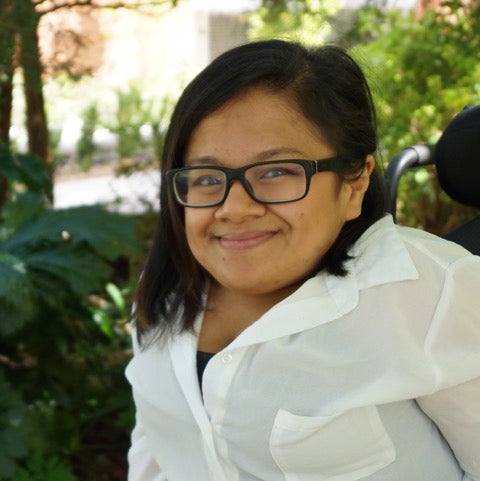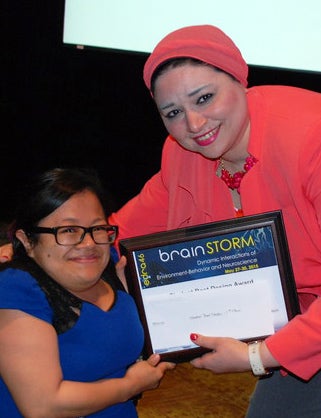For Olivia Asuncion, who was born with a physical disability and has used a wheelchair since age 13, fire drills were always a source of panic and anxiety.

Above: Olivia Asuncion hopes her research will encourage designers to make building evacuation more accessible to people with physical disabilities.
"I, for one, have been in many fire drills and evacuations where I definitely did not know what to do or where to go," says Asuncion, who graduates with a master of architecture degree this June. "I'm very fortunate that I am small enough so that if worse comes to worst, anyone could just pluck me out of my chair and take me down the stairs. But not all disabilities are the same."
She notes that some people in wheelchairs are equipped with oxygen tanks, and their wheelchair is an extension of their own body. Likewise, people with visual impairments or a hearing handicap require a respective set of accommodations to evacuate a building.
Since she began attending the University of Oregon, however, she's alchemized her worry into productive research that placed first recently at the Environmental Design Research Association competition.
Her design, which she started her first term at UO during a seminar, investigates the issues people with physical disabilities face during building evacuation, and offers potential solutions. Professor Jenny Young, Asuncion’s research adviser, taught the seminar and encouraged Asuncion to further pursue research on the topic.
“The credit for taking the initiative to follow through and develop this into a solid piece of research is all hers,” says Young. “Olivia's research is significant and has been done with thoroughness and with flair. She has investigated an important topic—accessible evacuation—through multiple lenses: a comprehensive literature search, her own experience and on-the-spot experiments, and interviews with a broad range of stakeholders.”
Asuncion presented her poster, and was announced as first-place winner, during the 46th annual four-day EDRA symposium in Los Angeles in late May.
“It was a great honor and privilege to receive first place in the Student Best Design Award at EDRA,” Asuncion said via email. “The conference was filled with many of the smartest and most hardworking professors, academics, professionals, and fellow graduate students in the field of environmental design. Being in the same room as them and having my opportunity to share my research with them was already reward enough. This award is just the icing on a very delicious cake!”
Asuncion focused her research on two buildings at UO: the often-remodeled Lawrence Hall, and the John E. Jaqua Academic Center, built in 2010.

Above: In Los Angeles, Asuncion accepts her first place honor in the Best Student Design Award international competition from Marwa Abdelmonem, student representative to the EDRA Board of Directors.
Informal interviews with physically disabled UO students aided Asuncion’s design work and provided anecdotal insight. One student told her that the idea of evacuating from upper floors is a scary and daunting experience.
“One of the most pertinent things she said was that she feels unprepared if there’s ever an evacuation on campus because of a lack of evacuation protocols,” says Asuncion, who graduated with a bachelor’s degree in architecture from the University of California in Berkeley in 2010. “Finding your way around buildings is really difficult.”
An administrator who is not disabled told Asuncion that in Lawrence Hall, with its convoluted wayfinding due to frequent remodeling, “given the number of people who cannot find their way daily under normal conditions, I would imagine a true evacuation emergency would be a real danger to many people.”
Asuncion’s design aims to improve fire safety and building evacuation for people with disabilities by making improvements to evacuation maps (so they can be read by people with visual impairments) and designing architectural wayfinding solutions that make it easier to navigate a building (using tactile maps with texture and color contrast).
Her design also offers an accessible vertical means of egress that allows building occupants to evacuate independently, citing as precedent a rescue elevator built into the Statue of Liberty’s life and safety renovation in 2012. Her research also
examines the need for “a more visible and comfortable area of refuge” for those unable to evacuate during an emergency.
Asuncion hopes that having this research recognized will encourage environmental designers to learn more about the inaccessibility of building evacuation.
“These solutions do not just benefit the small percentage of us with mobility or visual impairments,” her presentation states. “These changes can make architecture more beautiful but also widely usable. If we sear these lessons of accessibility and life safety and design into our brains instead of all those code-instituted measurements, we can potentially get rid of the term ‘universal design’ and turn it into ‘just design.’ Then the spaces that we built will be more inclusive, seamless, beautiful and safe.”
Although she used academic buildings on the UO campus as a case study, Asuncion says her proposed design can be implemented elsewhere.
“I think a lot of the solutions I proposed apply to multifamily housing, commercial buildings, or entertainment buildings,” she says. “It’s most beneficial to have it be accessible for everyone.”
Young remarked that Olivia is a “remarkable student—intelligent, well-organized, and hard-working. She has a sparkling personality and is a natural leader for whom and with whom people are delighted to work,” she says. “She has enriched our program with her warm and generous spirit and her passion for making the world more accessible for all of us.”
PhD candidate Christina Bollo, Associate Professor Ihab Elzeyadi, and Assistant Professor Daisy Williams also presented at EDRA.
The Student Best Design Award’s first place winner receives a $500 travel voucher, conference fee paid by the EDRA, and a one-year student membership.
Established in June 1968, EDRA emphasizes progress in architectural design in relation to the natural environment.

